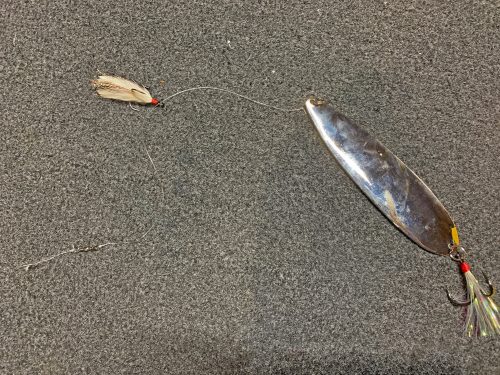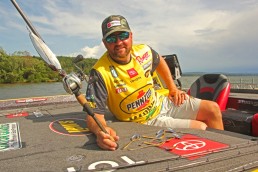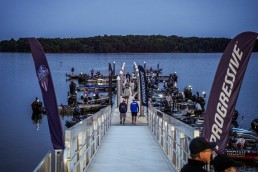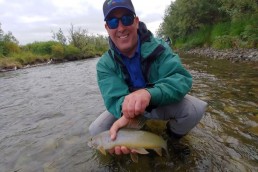Matt Arey on hot summer spoonin’
Alan McGuckin – Dynamic Sponsorships
Team Toyota’s Matt Arey had just slapped 21 pounds of Guntersville bass on the scales to take the tournament lead, yet he seemed equally as thrilled when a buddy handed him a giant, freshly squeezed $5 lemonade from a Bassmaster vendor located a short cast from the weigh-in stage.
It was hot. Like beat you down while you’re covered in sweat kinda hot. And while Arey had done most of his damage with a prototype ¾-ounce Titan Tungsten football jig, one of summer’s best-kept secrets sat ready to play nearby – an oversized 6” 2.5-ounce “flutter spoon” or what some call a “structure spoon.”
While not nearly as popular as mid-summer’s first string players such as football jigs, deep cranks, and giant plastic worms — pros like Arey know anytime you’re on a southern body of water full of big bass and plenty of shad – few lures fire up a fat school of largemouth like these flashy oversized spoons.
“The perfect time for a flutter spoon is anytime bass are ganged-up offshore and feeding somewhat deep on shad,” says the North Carolina pro, who has earned nearly $1 Million in prize money.
Where to throw it
While perhaps easiest to utilize in open water situations away from the bank, big spoons have proven super effective in recent years around the shade lines of deeper floating boat docks, and can also be fantastic to coax lethargic summer bass suspended deep in underwater treetops. Just don’t throw into a brushpile, because your chances of snagging it, and not getting it back run higher than the mercury in a mid-summer thermometer.
Don’t throw them far
Unlike a deep summertime crankbait — where Olympic distance casts are critical to the lure reaching and staying in the strike zone – a big, heavy spoon can find its way into a limited strike zone with quick precision. So a short underhanded cast or pitch is far better to probe a specific zone like a dock’s shade line, or the sweet spot on a road bed, or point.
The gear
“You’re dealing with a big lure, so a big rod with plenty of backbone is critical. I use a heavy action 7’ 6” rod like I’d use for pitching heavy cover,” says Arey. “And it’s really important to use a fast reel with an 8.1:1 gear ratio.” He spools the reel with 17-pound fluorocarbon for 6” spoons, and 20-pound fluro for even bigger spoons.
Add a stinger hook
While big spoons feature a meaty treble on their tail, Arey says adding an additional ‘stinger hook’ to the top of the spoon near the spit ring will not only increase your catch rates, but can actually help you catch two-at-a-time.

While some anglers tether a hook directly to the split ring, Arey adds a feathered treble through a rigging he credits former FLW pro Kyle Mabrey with teaching him, before Mabrey died tragically in a 2017 single vehicle accident. He uses a barrel swivel with a 12” leader tied between it and the feathered treble, to allow the extra hook to slide up and down the main line, so that when two bass are hooked at the same time they stayed buttoned-up.
While big oversized spoons are still far less popular than deep diving crankbaits, big worms, and football jigs in the heat of summer, their ability to fire up a lethargic school of fat largemouth is as undeniably good as an icy cold, fresh squeezed lemonade after a sweltering hot day on the water.


















